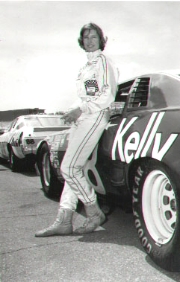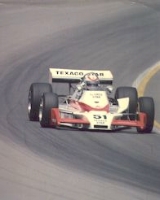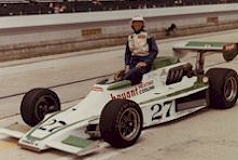

|
www.thundervalleyracing.com
|
|
|||||
|
by Christy Sampson
Janet Guthrie was the first woman to qualify and compete in the Indianapolis 500 (1977), and placed among the top ten finishers in 1978, despite driving with a broken wrist. (The speedway had previously banned women from the pits as timers, owners or reporters, and allowed women in the pits for the first time in 1971.) When her intentions were first announced, accepted wisdom was that 'women don't have the endurance or emotional stability' and the belief that women would endanger the lives of the male drivers on the track. Spectators shouted 'Go back to the kitchen' and 'Get the tits out of the pits'. Guthrie was also the first woman to qualify and compete in the Daytona 500, finishing as Top Rookie in the 1977 race. She was Top Rookie in five of her 19 Winston Cup rookie-season races, with three Top-Ten starts and four Top-Ten finishes, and led the last race of the season, the Ontario 500. Guthrie's best NASCAR Winston Cup career finish was sixth at Bristol (Tenn.) Motor Speedway in August 1977. This remains a landmark of the modern era.
When Janet Guthrie first set out to write the story of her adventures in motorsports, she had two objectives. "I wanted to convey the passion and complexity of auto racing to people who knew nothing about the sport; and I wanted to record how times were changing for women back then." In writing the book, Guthrie also wanted to let the reader see the sport through a driver's eyes. She hopes her book will contribute to the long historical record of what women have actually done in the world at large. Guthrie was one of the few drivers to compete in both the IndyCar and NASCAR series in the same season, along with such notables as Johnny Rutherford and A.J. Foyt. During one weekend in 1977, Guthrie successfully qualified and competed in the Ontario 500 IndyCar race in California, followed by a Winston Cup race in Darlington, SC. In an excerpt from her upcoming book, Guthrie tells the story of flying into Darlington at the last minute to find that she was denied access to the pits.
*** "Wonder Woman, of course, is make-believe, a TV character. However, Janet Guthrie is going to attempt a feat this weekend worthy of the fabulous female...She will try driving in two tough 500 milers on opposite ends of the continent within 24 hours..." Tom Higgins, Charlotte Observer August 31, 1977 Higgins, one of the most knowledgeable writers in stock car racing, wasn't exaggerating by an awful lot. The Ontario 500 USAC Championship race, which was my firm obligation to Rolla Vollstedt's Indy-car team, fell on Sunday, September 4, in California. The Southern 500 NASCAR race at Darlington ran next day, Labor Day, in South Carolina. The races themselves were just part of it. Practice, qualifying, and the Darlington rookie test would have to dovetail as well...
Thursday, September 1. After losing two engines in practice, plus a seized water pump and a disintegrated wheel bearing, I put Rolla's car in the field for the Ontario 500. We would start the race on Sunday just behind Gary Bettenhausen, just ahead of Billy Vukovich in Grant King's car. The obligatory microphones were waiting. I thanked the sponsors and the guys who stayed up all night changing engines; answered the inevitable "how does it feel to be the first woman to qualify for the Ontario 500?" In fifteen minutes, my ticketed airline flight for the first leg toward Darlington would depart from the Ontario airport. As I ran for the garage, I found a policeman running along with me. "I'll give you a ride," he gasped. Yay! I shed my Bryant driver's suit, threw on some clothes, leaped into the patrol car. "Where are your shoes?" Rolla yelled. I didn't know I was barefoot. Leaped out, ran for shoes. We screeched toward the airport with siren wailing, lights flashing. "We're all frustrated race drivers," the officer said. I made the plane. The wild ride to the airport was the most fun I'd had all day. Friday, September 2. Darlington, South Carolina, lay deep in redneck country, close by the Pee Dee River, in a land of scrub pine and sand. When the track was constructed in 1950 at a length of a mile and a quarter, paved with asphalt, it was unique in the South. The Labor Day race there, the Southern 500, became an instant classic... Practice here had started a day or two earlier. I had never seen the place. I followed the chain-link fence around the garage area, looking for the way in. At all their other superspeedways, NASCAR had a stand, booth, or trailer just outside the garage area entrance, where participants got their garage-area credentials. Not here. Finally, I asked directions of a man wearing whites, the white cotton pants and shirt that were the universal identifier of an official connection with a stock car racing event. "How do you get into the garage area?" He looked at me with barely concealed contempt. "You cain't," he said. I identified myself. "So you see, I need to get to my race car. Where is the entrance?" He looked away. I was wasting his time. "Through the cafeteria." "Where's that?" "Over yonder." He gestured vaguely while looking in the opposite direction, and I followed my nose. The place smelled wonderful, the homestyle cooking of the deep South. It was bustling with men in whites. They weren't NASCAR regulars; they were unknown to me, and I to them. A screen door at the back, sure enough, opened onto the other side of the chain-link fence. I walked up to it. A large man in whites barred my path. "Sorry, ma'am, you'll have to go out the other way." Again, I identified myself. The official team credential for the Southern 500 that I signed for at registration, at the track entrance, was pinned to my shirt. The guard pointed to the small print at the bottom. "No women or anyone under 21 allowed in pits," it read.
The infield was loud with the roar of practicing race cars. I needed to be among them. I said so. "Well, I'm sorry, ma'am, I'm just here to enforce th' rules, an' the rules are, we don't let no women in the garage ayrea. You say you're supposed to be in the garage ayrea, you'll have to get permission from Bill Gazaway." "Oh! Okay, I'll do that." Gazaway was the Director of Competition, the key figure at every Winston Cup race. We knew each other well by now. "Where's Gazaway?" "He's in the garage ayrea." We were still at stalemate when a member of someone else's crew came along. His positive identification of me cut no mustard whatsoever, but he volunteered to carry a message to Gazaway, wherever Gazaway might be. Gazaway was running the Darlington rookie meeting, as it turned out. When I finally got there, Darrell Waltrip was speaking. He had already qualified on the pole. "There's only one way through Three and Four. If you try to put two cars through there, you will crash. Both of you." Gazaway said, "We've had pileups here take fifteen cars out of the race." At the end of the day, I finally got my first few laps. What a
very narrow, lumpy, idiosyncratic track it was! On race day at Darlington, I got caught in the famous crash between Darrell Waltrip and Cale Yarborough that stimulated Cale to nickname Darrell "Jaws." However, we made repairs and were classified 16th out of 24 cars still running at the end.
More excerpts from Janet Guthrie's autobiography can be found on
her web site at:
|
|
Home
| Member Area
|Meet the Racers
| Features
| News Articles Sponsorship
| Press Room
| Resources
| About Us
| Contact Us
|



